- Home
- Jared Diamond
Upheaval: Turning Points for Nations in Crisis Page 14
Upheaval: Turning Points for Nations in Crisis Read online
Page 14
Resolutions of most national crises require numerous policy changes, which may either be adopted piecemeal or else may all be part of one unified vision. Meiji Japan is our case study that comes closest to the latter extreme of the unified vision. That isn’t to say that Meiji leaders launched all of their policy changes simultaneously: they knew that some problems were more urgent than other problems. They began by creating an imperial army, implementing tax reform, and solving a few other pressing matters in the early 1870’s, but did not unleash their first full-fledged overseas war until 1894. However, all of these policies stemmed from a principle on which agreement had been reached at the beginning of the Meiji Era: the need to strengthen Japan in many different spheres, by learning selectively from the West.
Meiji Japan has thus offered us a good second case for exploring the issues involved in resolving national crises through selective change. Finland (our first case) and Meiji Japan were similar in facing crises that exploded on one day, when an external military threat that had been developing for years suddenly materialized. Both Finns and Japanese have strong national identities and core values that they defended by sacrificing their lives against overwhelming odds; the Japanese were put to that test in World War Two rather than in the Meiji Era. Both Finns and Meiji Japanese were brutally honest and realistic. In some other respects, though, Finns and Meiji Japanese found themselves at opposite extremes. Meiji Japan received help from many nations, the very ones that threatened it; Finns received virtually no help during the Winter War. Japan solved its problems by drawing on abundant models; Finland could draw on none. Japan’s large population, economic strength, and distance from its enemies gave Japan the time and space necessary to achieve military equality with the nations threatening it; the proximity and relative sizes of Finland and Russia eliminated that option for Finland. In the next two chapters we shall turn to nations whose crises climaxed as suddenly as did those of Finland and Meiji Japan, but whose explosions were internal.
FIG. 4 Map of Chile
CHAPTER 4
A CHILE FOR ALL CHILEANS
Visiting Chile—Chile until 1970—Allende—The coup and Pinochet—Economics until “No!”—After Pinochet—Pinochet’s shadow—Crisis framework—Returning to Chile
In 1967 I spent a sabbatical in Chile, at a time when everything there seemed peaceful. My Chilean hosts emphasized to me that Chile was very different from other Latin American countries. Chile had a long history of democratic government, they explained, punctuated by only a few relatively bloodless military coups. Chile didn’t have frequent military governments, as did Peru and Argentina and other South and Central American countries. It rated as the most politically stable country in all of Latin America.
Chileans identify with Europe and with the U.S., rather than with Latin America. For instance, my visit to Chile was under a University of Chile / University of California exchange program. That program had been founded not just to recognize the geographic fact that Chile and California occupy similar positions in the Mediterranean zones on the west coasts of their respective continents—but also to acknowledge that Chile and California are similar in their social atmosphere and political stability. My Chilean friends summed it up by the sentence “We Chileans know how to govern ourselves.”
But just six years after my visit, in 1973, Chile was taken over by a military dictatorship that smashed previous world records for government-perpetrated sadistic torture. In the course of a military coup on September 11, Chile’s democratically elected president committed suicide in the presidential palace. Not only did the Chilean junta kill Chileans in large numbers, torture them in larger numbers, devise vile new techniques of psychological and physical torture, and drive still more Chileans into exile. It also directed terrorist political killings outside Chile, including what was, until the World Trade Towers attack of September 11 of 2001 (coincidentally on the anniversary of Chile’s coup), the only terrorist political killing of an American citizen on American soil (in Washington, DC, in 1976). That military government remained in power for almost 17 years.
Today, 29 years after the military government stepped down, Chile is struggling with that government’s legacy. Some torturers and military leaders have been sent to prison, but the top military leaders were not imprisoned. Many Chileans, while deploring the torture, still view the military coup as necessary and unavoidable.
As you read about recent Chilean history in the following pages, you’ll find many questions to keep in mind. How can one explain such an abrupt reversal of direction in a country with strong democratic traditions? How can Chile and other countries deal with a hideous recent past? How do this book’s themes of national crisis and change play out in Chile? You’ll recognize big selective changes in government economic policy and in political compromise. You’ll also recognize some recurrent themes: honest self-appraisal and the lack thereof, freedom of action and the lack thereof, support or opposition from allies, and the role of a model or a presumed model. Two of Chile’s leaders pose the recurrent historical question of whether leaders with distinctive personalities really change the course of history.
Most of all for my fellow Americans, Chile raises a frightening question to keep in mind as you read this chapter. The U.S. shares with Chile a strong democratic tradition. The yielding of that tradition to a dictatorship seemed utterly inconceivable to Chileans in 1967, just as it seems inconceivable to many Americans today. But it did happen in Chile, and the warning signs there were visible in retrospect. Could it also happen to the U.S.?
Let’s begin with Chile’s geography, history, and people. When you look at a map you’ll be struck by the fact that Chile is the longest and thinnest country in the world. While averaging only slightly more than 100 miles wide from west to east, it’s nearly 3,000 miles long from north to south: almost as long as the U.S. is wide. Geographically, Chile is isolated from other countries by the high chain of the Andes in the east separating it from Argentina, and by the world’s most barren desert in the north separating it from Bolivia and Peru. As a result, the only foreign wars that Chile has fought since achieving independence were two with its northern neighbors Bolivia and Peru in the years 1836–1839 and 1879–1883.
Despite that enormous length, Chile’s productive farmland, agriculture, and population are concentrated in just a fraction of the country’s area, within the Central Valley surrounding the capital city of Santiago. Only 60 miles from Santiago is Chile’s main port of Valparaíso, the largest port on the west coast of South America. That geographic concentration, plus Chile’s ethnic homogeneity mentioned below, has contributed to the unity of Chile, which has never had to deal with the geographic secessionist movements that have plagued most other countries of Chile’s territorial extent.
Unlike South America’s other countries, which are tropical, Chile shares with Argentina and Uruguay the two big advantages resulting from being located in the temperate zone at the southern end of South America. Those advantages are the higher average agricultural productivity and the lower average disease burden of temperate-zone areas compared to the tropics. As a consequence, Chile, Argentina, and Uruguay are the South American countries with the highest average per-capita incomes, even despite the chronically misguided economic policies of Argentine governments. Chile’s relative prosperity arises from its agriculture, fisheries, minerals (more about that below), and manufacturing industries. Chile was already a big exporter of wheat to both California and Australia at the time of the Californian and Australian gold rushes of the 1840’s, and has remained an agricultural exporter ever since. In recent decades Chile became the leading exporter of fish products in South America, and among the leading ones in the world. Chile eventually developed more manufacturing than did most other Latin American countries.
As for Chile’s history and people, before European arrival the area that is now Chile supported only a sparse Native American population, lacking the cultural and political achievements of the rich
, populous, powerful Inca Empire to the north in what is now Bolivia, Peru, and Ecuador. As in most of the rest of South and Central America, the Europeans who conquered and settled Chile were Spaniards, beginning in the 1540’s. They imported few African slaves and intermarried with the Native Americans. Thus, unlike most other South American countries, Chile today is ethnically rather homogeneous and doesn’t have large unmixed Native American or African minorities. Instead, Chileans are overwhelmingly Spanish and mestizo (meaning the mixed offspring of Spaniards and Native Americans), almost all of them Catholic, and almost all of them Spanish-speaking (unlike the large minorities speaking Native American languages in other Latin American countries). The largest minority group, the Mapuche Native Americans, constitutes only 1% of the population. Relatively few people are of other than Spanish and Native American ancestry.
Thus, Chile’s geography, history, and people have all contributed to its unity. That’s been a positive force in Chilean history, tending to make it less tumultuous than the histories of other Latin American countries. But a big negative force is one that Chile does share with many other Latin American countries: Spanish colonists established large land-holdings unlike the small farms established by European settlers of North America. Hence whereas the U.S. and Canada developed broad-based democratic governments from the very beginnings of their settlement by Europeans, in Chile a small oligarchy controlled most of the land, wealth, and politics. That concentration of political power has constituted a basic problem of Chilean history.
The underlying conflict between the intransigent oligarchy’s traditional power and the rising power of other classes of society could either have been resolved through political compromise or have remained unsolved due to political stalemate. The latter outcome became increasingly frequent after Chile adopted in 1925 a new constitution that staggered the elections of the president, Senate, and lower house of Congress among different years. That well-intentioned idea, adopted in the name of the virtuous principle of balance of power, unfortunately resulted in the presidency, control of the Senate, and control of the lower house usually belonging to different political parties, depending on which party happened to be strongest in a particular election year. Two further subsequent changes in voting procedures increased the left-wing vote at the expense of the oligarchy’s previous dominance. One change was that Chilean women finally obtained the right to vote in municipal elections in 1934, and in presidential elections in 1949. The other change was that voting in Chile had traditionally been open and in public, making it easy for land-owners to observe and influence how peasants voted. Hence adoption of voting by secret ballot in 1958 produced a leftwards shift.
Chilean political parties came to constitute three blocks—left, center, and right—that were similar in strength. Hence the government was variously either left-controlled or right-controlled, depending on which way the center chose to lean. Each of those blocks themselves contained more extreme and less extreme elements in conflict with each other. For example, within the left block, there were moderates (including most orthodox communists) who wanted to achieve change by constitutional means, competing with a radical left that was impatient and wanted revolutionary change. The army stayed out of modern Chilean political struggles—until 1973.
Chile’s most recent presidential election before I lived there in 1967 had taken place in 1964. Exceptionally for Chile, where the leading presidential candidate had usually obtained just a plurality rather than a majority of votes, the 1964 election produced a big majority for the center’s candidate, Eduardo Frei. He was regarded as well-intentioned and honest. Fear of the Marxist program and rising strength of the left-wing coalition led many right-wing voters to support Frei, and his party also won control of Congress’s lower house in the 1965 elections. That raised hopes that Frei could adopt major change and end Chile’s political gridlock.
Frei acted quickly to enable the Chilean government to buy 51% control of Chile’s U.S.-owned copper-mining companies. He poured government investment into the Chilean economy, expanded access to educational opportunities for poor Chileans, succeeded in making Chile the biggest per-capita recipient of U.S. economic aid in Latin America, and initiated a program of agrarian reform to break up large land-holdings. But Frei’s ability to change Chilean society was restricted by Chile’s long-standing political stalemate. On the one hand, Frei’s program was too radical for the Chilean right. On the other hand, Frei wasn’t radical enough for Chilean left-wingers, who wanted even more Chilean control of the copper-mining companies, even more government investment, and even more land redistribution. Under Frei, the Chilean economy continued to suffer from strikes, inflation, and shortages. For instance, during my months in Chile there were chronic meat shortages: even whale meat and tough beef were available in butchers’ shops only occasionally, although sheep eyes were available every day of the week. Friends of mine fell victim to street violence. By 1969, all three Chilean political blocks—right, left, and center—were feeling frustrated by Chilean politics.
Developments in Chile from 1970 onwards were guided by two consecutive leaders who represented opposite extremes in politics and personality: Salvador Allende and Augusto Pinochet. They were similar only in sharing the fact that, to this day, it remains unclear why each of them acted as he did.
My understanding of Allende is based on public information about him, and on the recollections of a Chilean friend of mine who knew him and his family well. Allende was a quintessential Chilean professional, from an upper-middle-class family, rich, intelligent, idealistic, a good speaker, and endowed with an appealing personality (Plate 4.1). Already in his student days he became a declared Marxist, and a founder of Chile’s Socialist Party, which was more extreme left-wing than Chile’s Communist Party. But Allende rated as moderate by Chilean socialist standards, because his aim was to bring Marxist government to Chile by democratic means, not by armed revolution. He graduated medical school, and at the age of just 31 became Chile’s minister of health, a job that he carried out with acknowledged success. He ran for president of Chile in 1952, 1958, and 1964 and was defeated all three times, twice by large margins. Hence by the time that Allende once again ran for president in 1970 at the head of a Popular Unity coalition of socialists, communists, radicals, and centrists, his reputation was that of an unthreatening perennial loser.
In the 1970 elections Allende received the largest share of the popular vote (36%), but only barely, because the much larger percentage (64%) of the electorate opposed to him was split between a right-wing coalition (35%, only 1.4% lower than Allende’s share!) and a center coalition (28%). Since Allende had obtained only a plurality rather than a majority of votes, his election required confirmation by Congress, which did confirm him in return for a series of constitutional amendments guaranteeing freedom of the press and other freedoms. Despite the unthreatening personality and history of behavior of Allende himself, his election immediately provoked an unsuccessful attempt by the U.S. government to muster Chilean congressional support for rejecting his confirmation, and also provoked the emigration of the family of one of my Chilean friends who didn’t care to wait and see what policies Allende would implement. Why was the election of that gentle moderate as president greeted with such a strong negative reaction?
The reason was Allende’s and his party coalition’s declared goal of bringing Marxist government to Chile: a prospect that horrified the Chilean right-wing and centrists, the Chilean armed forces, and the U.S. government. Today, decades after the collapse of the Soviet Union and the end of the Cold War, my younger readers who were not alive during the 1940’s, 1950’s, and 1960’s cannot imagine why those powerful constituencies were so adamant that a Marxist government in Chile had to be forestalled by any means. The explanation begins with the fact that, after World War Two, the Soviet Union embarked on a policy of world domination and developed its own atomic bombs, hydrogen bombs, and intercontinental ballistic missiles. It attempted to strangle
democratic West Berlin in 1948 by closing all road access. It carried out brutal communist take-overs and bloody crushings of revolts in Czechoslovakia, East Germany, Hungary, and Poland. It established dictatorships propped up by Soviet troops in those and other Eastern European countries.
Most dangerous of all, after Fidel Castro had installed a Marxist government in Cuba, Castro and Khrushchev began to station ballistic missiles to be armed with nuclear warheads in Cuba only 90 miles from the coast of the U.S. For one terrifying week in October 1962, seared unforgettably into the memories of all of us who were alive then and old enough to remember it, the world was closer to the brink of nuclear war than at any other time in history, before or since (Plate 4.2). Subsequent to the crisis, the gradual release of formerly classified information by both the U.S. and the Soviet Union made clear that we had been even closer to destruction than had been appreciated at the time. Unbeknownst to America’s military leaders then, who knew that at least 162 missiles had already been stationed in Cuba but who thought that the missiles’ nuclear warheads had not yet arrived, many of the warheads had actually already reached Cuba.
After the Cuban Missile Crisis, the Soviet Union responded by accelerating its programs to develop more powerful nuclear weapons and intercontinental ballistic missiles. The U.S. responded with the determination that never again would it tolerate the installation of a communist government in the Western Hemisphere. Any American president who failed to prevent such an installation would have been immediately impeached and removed from office for gross neglect of American interests, just as President Kennedy was warned that he would be impeached if he failed to get Soviet missiles out of Cuba. Beginning in the 1960’s, the U.S. also became preoccupied with communist threats in Vietnam and other Southeast Asian countries. The Chilean right, center, and armed forces were equally adamant that there would be no Marxist government in Chile, because they had seen what had happened to Cuba and to anti-Marxist Cubans after Castro had come to power. They wouldn’t tolerate that history repeating itself in Chile.

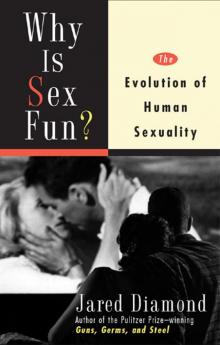 Why Is Sex Fun?: The Evolution of Human Sexuality
Why Is Sex Fun?: The Evolution of Human Sexuality Guns, Germs, and Steel: The Fates of Human Societies
Guns, Germs, and Steel: The Fates of Human Societies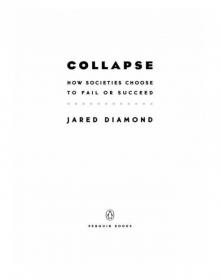 Collapse: How Societies Choose to Fail or Succeed
Collapse: How Societies Choose to Fail or Succeed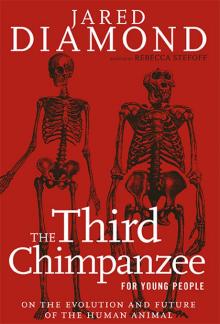 The Third Chimpanzee: The Evolution and Future of the Human Animal
The Third Chimpanzee: The Evolution and Future of the Human Animal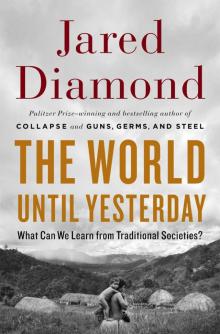 The World Until Yesterday: What Can We Learn From Traditional Societies?
The World Until Yesterday: What Can We Learn From Traditional Societies?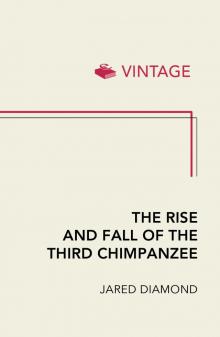 The Rise and Fall of the Third Chimpanzee
The Rise and Fall of the Third Chimpanzee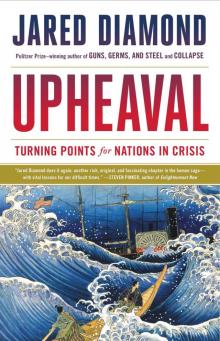 Upheaval: Turning Points for Nations in Crisis
Upheaval: Turning Points for Nations in Crisis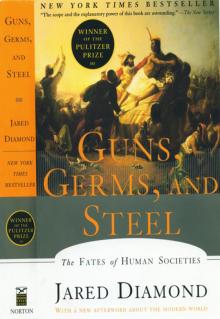 Guns, Germs, and Steel
Guns, Germs, and Steel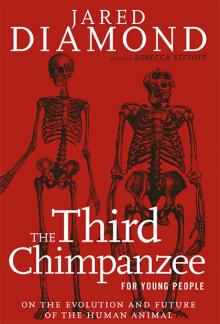 The Third Chimpanzee for Young People
The Third Chimpanzee for Young People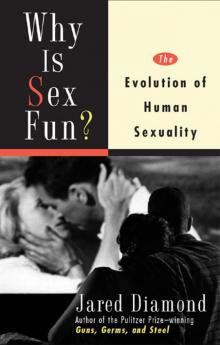 Why Is Sex Fun?
Why Is Sex Fun?